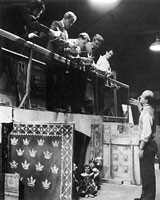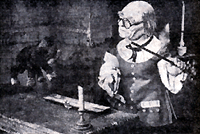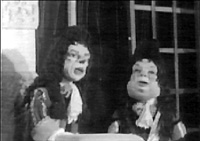
Picture
Gallery - Part 1
1955
- 1960
BBC
Puppet Theatre at Lime Grove Studios
(the Tin Shed days)
|
One visitor to the Tin Shed, Ernest Thomson, was impressed enough to write about his experience for the Radio Times. Here are the relevant parts of his article:
|
||
|
|
||
 (click for larger image 138K) |
A
colourised photograph of the
original King and Queen of Rubovia with their Chamberlain, as never seen
on the UK 405-line monochrome television system, 1955. These
small string
marionettes were made by Kim Allen and used in the first three Rubovia Legends
plays, starting with The Queen's Dragon (B&W, live transmission, 1955). That these puppet characters look relatively normal beside their
later, larger, and more caricatured, replacements, suggests that Gordon Murray had
not yet fully flexed his artistic skills.
Points of Interest: The original B&W picture was published in Television Puppet Theatre by Gordon Murray, The Puppet Master June 1956, ? BBC. Colourisation ? 2003 Alastair Roxburgh. |
|
|
|
||
 (click for larger image 42K)
|
Producer
Gordon Murray directing his puppeteers in a non-Rubovia puppet play, The
Emperor's New Clothes, 1958. The puppeteers are (L to R): John
Hardwick, unknown, Roy Skelton, Bob Bura, James Beattie.
The puppeteer bridge in the Tin Shed was made from Dexion
angle steel, which can be seen in the picture to extend across two
different sets (it actually spanned three). The floor of the bridge was
4 feet above the stage. The original Rubovia puppets (used in The Queen's Dragon
and the two other plays in the first production series) were
about 13 inches tall (1/5 life-size), similar to the puppets in this photograph, which
gives a scale height for the scenery wall of about 18 feet. |
|
|
|
||
 (click for larger image 81K) |
A tense
meeting between (L to R) The Lord Chamberlain, King Rufus, Queen
Caroline, and Mr. Albert Weatherspoon on the set of Clocks and Blocks,
August 1958. Also present are Pongo, the
Queen's baby dragon, and Mr. Weatherspoon's cat, Rubina ('puss'). The old
405-line UK B&W television system never looked this good!
Points of Interest: B&W picture sepia-toned and colourised using existing colour photographs as a guide to the correct colours. If you look carefully it's possible to make out a palace guard in the background, behind the King. The "tapestry" hanging behind the Lord Chamberlain was painted by Andrew Brownfoot for the non-Rubovia puppet play, The Emperor's New Clothes, and was inherited by the Rubovian Royals following that production. A larger view of the tapestry, hanging exactly the same way it does here, appears in Andrew and Margaret's biography, and serves to date this photograph. Clocks and Blocks
was the first "Rubovian Legends" episode with the new larger-sized and
more caricatured puppets. |
|
|
|
||
 (click for larger image 64K) |
In a publicity still from The Wonky Wand, first transmitted 8th December 1959, Mr. Albert Weatherspoon is preparing for a Royal Command performance of some magic tricks, as evening entertainment visiting royal guest, King Boris of Borsovia. Having removed ye old wand from ye old wand case, Weatherspoon is seen here testing it to check if it still works. Apparently it does, as puss is now floating in the air at candlestick height above the table top! Point of Interest: The 1976 stop-motion episode, The Unreliable Wand, was a remake of this episode. Soundtrack of remake is available on BBC LP REC282 Side 1, simulated stereo. This picture was published in Come to the Puppet Theatre, by Earnest Thomson, Junior Radio Times, Supplement to the Radio Times, 4th October 1959, and is ? BBC. |
|
|
|
||

|
A video still from Wonky Wand, first transmitted 8th December 1959. King Rufus and the Lord Chamberlain are sharing a private joke at Queen Caroline's expense. |
|
|
|
||
|
|
||
 Six weeks in preparation, a Rubovia play goes out live on BBC Children's Television Points of Interest: Visible in this photograph, which was taken in the BBC's "Tin Shed" at Lime Grove, are four BBC-TV cameras, seven crew, and two puppets on the centre stage. The photograph is not clear enough to determine if this is a scene from "Rubovia Legends", or one of Gordon Murray's other puppet plays. The puppeteers are out of sight above the stages on the bridge. Only the first three Rubovia episodes were transmitted live, and whereas they required four TV cameras and a crew to match, the later episodes were filmed with a single 16 mm film camera operated by Gordon Murray himself. This photograph was published in the May 7, 1959 issue of The Stage and Television Today. |
||
|
|
||